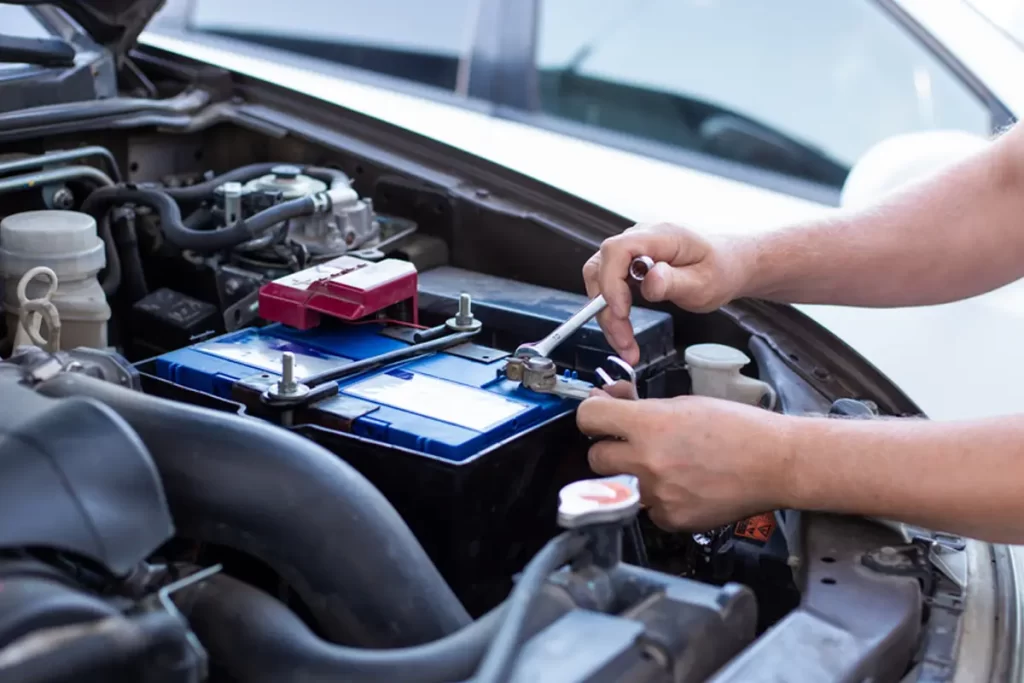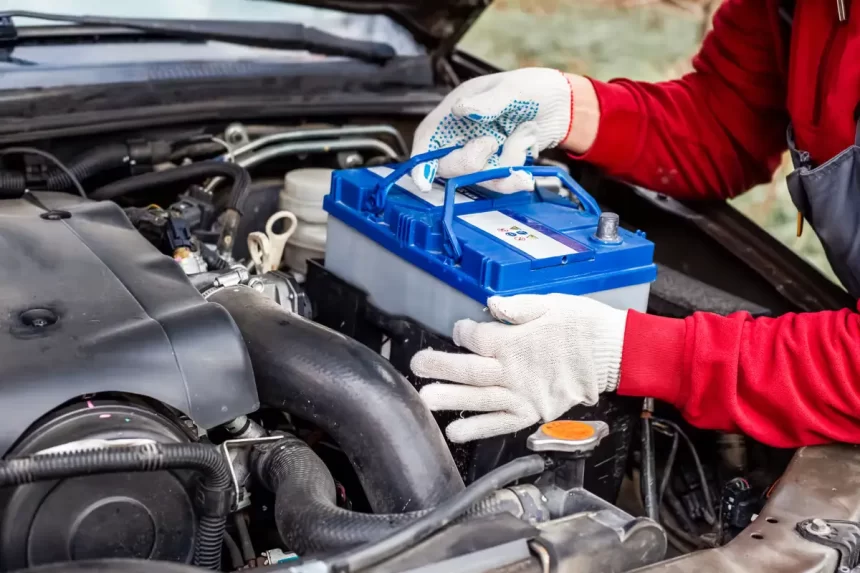Have you recently been unable to start your car due to a faulty battery? You were probably frustrated and began looking for a ‘car battery near me’ and ‘best car battery brands in India’ on Google. But the results were so confusing! There are so many brands, types, and sizes of batteries that it’s bound to overwhelm you. Lucky for you, this blog will tell you how to choose a new car battery with simple and informative instructions.
Batteries are an important and often overlooked component of cars. Your car battery provides the energy needed to start your engine and also powers your lights, electric systems, and accessories. Choosing the right car battery replacement will keep your car running smoothly for years to come. In this blog, we’ll demonstrate how to choose a new car battery and what factors you must consider during the process.
How Do I Know When My Car Battery Has Stopped Working?

Skip this section if you’re 100% sure that you’re dealing with a dead car battery and would rather move onto the steps on how to choose a new car battery.
If you’ve tried starting your car unsuccessfully, your battery may be at fault. However, it could just as easily be another component malfunctioning. Before you choose a new car battery, it’s better to make sure that you are really dealing with a dead battery or battery issues.
- Dim headlights
- Trouble starting the engine
- Engine problems in cold weather
- Battery isn’t charging
- Check engine light turns on
- Cracked battery case
- You smell a strange odour
- Loose battery terminals
- Malfunctioning electrical components
- Battery is swollen or bulging
If your car battery is dead, you’ll need to know how to choose a new car battery yourself. So, without further delay, let’s get into the nitty-gritty of how to choose a new car battery.
Size
The first criteria while shopping for a car battery replacement is size. Battery sizes are standardized by the BCI (Battery Council International), so they remain consistent even in different countries. All car batteries fit into particular BCI size categories, so a BMW car will have a different battery size compared to a Maruti Suzuki XL6.
Knowing the right shape and size will help you how to choose a new car battery easily. You will find your car battery size easily by checking the owner’s manual of your car or looking at the label of your old car battery.
BCI groups classify car batteries by their dimensions (height, length, weight), voltage, chemistry, and polarity (the location of the battery posts). The car batteries in BCI groups are separated into three categories based on polarity or the location of the terminals: standard top post, recessed top post, and side post batteries.
Standard Top Post
Standard top post batteries are the most commonly used type of car battery in India. Most American and Japanese car manufacturers use these batteries. The following BCI groups fall under standard top post batteries: 24, 24F, 25, 34, 35, 51, 51R, 52, 58, 58R, 59, and 65.
Recessed Top Post
Recessed top post batteries feature the battery posts recessed in a corner rather than directly on top. These batteries are commonly installed under the back seat or in the trunk and feature special inbuilt ventilation systems.
German and European car manufacturers (Audi, BMW, Volkswagen) use recessed top post batteries. The BCI groups 41, 42, 47, 48 and 49 fall into this category.
Side Post
Side post batteries feature cable ends on the side rather than on top of the battery. Side post batteries are divided into group sizes 70, 74, 75 and 78.
Type of Battery
The most common type of car battery is the lead-acid or wet battery. Lead acid batteries feature lead plates submerged in a solution of electrolytes. Water and sulfuric acid in the solution react with lead and lead oxide to generate electricity.
If you or a family member owned a car in the nineties, you may be familiar with the process of pouring distilled water into the battery. When the water inside the battery evaporates, the energy it generates may decrease. Thus, some lead acid batteries require distilled water to be poured over them to maintain the acid level inside the battery.
Nowadays, many lead-acid batteries are engineered to reduce water loss and are maintenance-free. Lead acid batteries are further categorized into SLI and Deep Cycle batteries, of which SLI batteries are used most often in cars.
Deep Cycle Battery
A Deep Cycle or marine battery is a sealed lead-acid battery that is built for continuous electric output over long periods of time. They discharge a lower voltage but can do so for long periods.
Thus, deep cell batteries can be used as a steady source of power and be repeatedly used and recharged. Unlike SLI batteries, they do not charge via the alternator but require an external charger. These batteries are sometimes used on electric vehicles and off-road cars.
SLI Battery
Most cars in India are equipped with stock SLI (Starting, Lighting, Ignition) batteries. This battery provides a high amount of current in a short time period. They provide an instant burst of power when you start the car and crank the engine. The alternator takes over shortly after, as the car doesn’t need electric energy to run anymore.
SLI batteries deliver a high current quickly and also charge quickly, but aren’t suitable for continuous electric use. SLI batteries are divided into flooded lead-acid (FLA) batteries and sealed lead-acid (SLA) or valve-regulated lead-acid or VRLA batteries.
Flooded-Lead Acid Battery
Conventional flooded batteries are a very common type of car battery. They have been around for a long time and are still being used today. They are very affordable and reliable but require regular maintenance, don’t function well in extreme temperatures, and typically have lower CCAs.
You’ll have to check these batteries on a regular basis and top them up with distilled water as and when required.
VRLA Battery
SLA and valve-regulated lead-acid or VRLA batteries are sealed and do not need any maintenance, such as distilled water top-ups. While flooded batteries have openable caps, these batteries have sealed caps. They are designed to be compact and leak-proof and are ideal for cars that don’t have a large space for the battery. They also last longer than flooded batteries.
VRLA batteries are further divided into Gel Cell batteries and Absorbed Glass Mat Batteries.
Gel Cell Battery
A Gel Cell Battery contains electrolytes, but in gel form. Gel cell batteries use a silica additive to thicken the solution, which results in lower recharge voltages compared to other battery types.
This makes them leak-proof and highly resistant to heat, evaporation, and physical shocks. They are usually corrosion free, require minimum maintenance, and have a long lifespan.
Absorbed Glass Mat Battery
AGM or Absorbed Glass Mat batteries, are filled with liquid electrolyte solution, which is held in place and absorbed by glass mats. Since the liquid can’t flow freely, there’s a lower risk of spillage and leaks. AGMs work like normal wet cell batteries but provide better durability and performance thanks to special paste formulations and optimized oxygen recombination cycles.
AGMS are less durable than flooded batteries because they are very sensitive to high temperatures and overcharging. Vehicles that have features like heated seats or remote start and stop technology will often use AGM batteries due to their higher CCA output.
Lithium Battery
Litium is a lightweight metal but has an exceptionally high energy density. Lithium ion batteries are safe, high-energy, efficient, and environmentally friendly. They are among the most expensive and best car batteries you can buy. These types of batteries are ideal for high-performance vehicles.
Also read: Simple Ways to Protect Your Car From Scratches
Consider Technical Measurements
The next step in your journey of ‘how to choose a car battery’ is to understand the technical terms associated with car batteries and how they impact practicality and performance.
Ampere-Hour (Ah)
Ampere-Hour ratings tell you how long the car battery will be able to provide a certain amount of amperage. This rating measures how powerful the battery is. Usually the ratings use a standard amperage of 12V for cars.
Cold-Cranking Amps (CCA)
Next, let’s talk about CCA. Cold Cranking amps describe the engine-cranking power of the battery in cold weather. CCA is the measurement of how much electric current or amperage a battery can provide for 30 seconds at minus 18 degrees Celsius or 0 degrees Fahrenheit. A bigger CCA number means that the engine has a lot of cranking power even in cold weather.
You’ll have to take into account both CCA and Ah while choosing a new 4 wheeler battery. Your car manual will usually specify the minimum Ah or CCA numbers that your car requires. You can go above these numbers, but make sure to never go lower. If you don’t meet the minimum power requirements, you may be unable to start your engine.
Choosing a battery with an Ah rating that’s way higher than your car’s specified number will put additional strain on the alternator and slow down the charging process. However, if you live in a cold climate, it would be advisable to get a battery with a higher CCA rating than specified.
Reserve Capacity
The battery’s reserve capacity measures how much time it can run and provide power to the car’s accessories or headlights while the engine is off or the alternator fails. A high battery reserve capacity can save you in tricky situations, such as when your battery is unable to charge or your alternator fails. It can keep your lights running and help you charge your phone in an emergency. The RC rating of a battery is usually written on its label.
Freshness
When buying a car battery, make sure that you buy batteries that are not older than six months. This is because batteries can lose strength even when they are not in use. The age of the battery when you buy it is commonly called its ‘freshness’. Batteries you buy should never be older than 6 months old.
The battery’s manufacturing date is often mentioned on its label as a number or an alphanumeric code. The code is simple: the first character will be a letter from A to L (I is skipped), which denotes the months from January to December. The second will be a number from 0 to 9, which represents the last digit of the year of manufacture. So 0 is 2020, 4 is 2024, etc.
Warranty Length
Wait a minute: why is warranty length important? Earlier, we said that batteries last about 3 to 5 years on average. However, the actual lifespan of your battery depends on where you buy it and what type of battery it is. While choosing a car battery, make sure that you have at least a three-year warranty on it.
Batteries that come with long warranty periods and provide free replacements are often more durable and trustworthy than other cheaper options. Even though they may cost you a bit more, buying a high-quality battery that lasts six years will be cheaper than replacing your battery every 1 to 2 years.
Keep your warranty card safe and if you’re buying on a third-party app or website like Amazon, make sure to read the terms and conditions of the warranty carefully to make sure it applies to online purchases.
Weather
The environment or place you drive your car is an important factor to consider while choosing a new battery. Certain battery types, like AGM, are more resistant to extreme weather conditions and will provide excellent performance in such conditions. On the other hand, regular flooded batteries won’t last as long and you may need to replace them more often.
Consider Your Driving Habits
Keep your driving habits in mind while choosing a new battery. If you are someone who drives long distances regularly, a battery with higher CCA would be ideal. On the other hand, if you take many short trips or use your car infrequently, choose a battery with a high reserve capacity; the engine will stay charged even if you don’t use it for a long time.
Buy From a Reputed Brand
Don’t leave your car’s performance to a shady manufacturer. The final step in learning how to choose a new car battery is to always buy from a reputed brand. While buying a car battery, make sure to read reviews from other buyers, compare prices online, ensure that the warranty terms are reasonable, and that you’re buying from the best 4 wheeler battery brand.
Buying a reliable car battery can save you from tricky and unexpected situations. So don’t cheap out on your car battery! Always buy car parts and accessories from reputed, highly-rated, and well-known brands. Here are some of the best car battery brands in India, listed in no particular order:
How to Choose a New Car Battery for My Car
First, list out the size, shape and specifications of the battery you require. Next, decide what you want from your battery—should it have a long reserve capacity, high CCA, or something else? Then, use those requirements to select the type of battery you want to buy, and make sure that it is compatible with your car.
While lead-acid batteries are the most common type, you can choose ge-cell or AGM batteries instead, as they have longer lifespans and can work well in extreme temperatures. Another important note: you can usually upgrade from the type of battery that your car came with, but you can’t downgrade. So if your car came with a lead-acid battery you could probably switch to AGM, but if it came with an AGM, we wouldn’t recommend switching to a lead-acid.
You don’t have to be a battery expert to know how to choose a new car battery. You simply need to be well-informed about the basics and specifics. If you are still hesitant about choosing a battery yourself, do your research first and then speak with a representative at an offline store. You can also look for advice from other car owners by joining online forums and discussion boards.
How to Make My Car Battery Last Longer
Are you worried about your battery’s lifespan? While car batteries typically have shorter lifespans in hot climates, there are some ways that you can increase your battery’s lifespan.
Regular Maintenance
Check up on your car’s battery regularly for signs of damage, sulfation (buildup of lead sulfate crystals), or corrosion. Keep it charged even when you’re not using your car. If possible, try taking your car out for a short while to prevent long periods of inactivity. If necessary, you can clean battery terminals with a solution of water and baking soda.
Get Your Battery Tested
You can get your battery load-tested by a mechanic and test its ability to charge and hold voltage effectively. We recommend getting your battery tested at least once a year, and especially before making a long trip.
Clean Battery Terminals
You can use a wire brush and a corrosion cleaner to clean car battery terminals. This prevents grease, dirt, and corrosion from building up. However, be careful and wear protection while dealing with harsh chemicals.
Park in the Shade
Extreme heat and cold can damage your car battery and shorten its lifespan. Heat can cause more damage than the cold. To prevent this, park in a shady place, and always choose indoor instead of outdoor parking spots.
Drive Regularly
Try driving your car regularly and avoid long periods of inactivity. Turn your car accessories off when the car is not in use.
Also read: Tips to Improve Car Mileage
How Long Does a Car Battery Last?
Factors like weather and temperature have a noticeable impact on the average car battery life in India. In general, batteries last longer in cold climates than in hot ones. This is because the heat can cause your battery’s electrolytes to evaporate and affect its charge. In fact, batteries last 2-3 times longer in cold climates as it slows down chemical reactions and degradation.
Along with weather conditions, the length of your trips, age of your vehicle, and maintenance can all have an impact your car battery’s lifespan. The average automobile battery life in India is 4 to 5 years.
We’ve done our best to answer your question, ‘How to choose a new car battery?’. What topic would you like us to cover next? Let us know in the comments below!
Note: Do not throw your dead battery in the trash; it contains harmful chemicals like sulfuric acid and lead dioxide. Instead, take it to a car retailer, a recycling facility, or a hazardous waste disposal center, or ask the mechanic who replaces your car battery to dispose of it for you.
Frequently Asked Questions (FAQs)
What is the average car battery price in India?
In India, a car battery costs about Rs 4,000- 16,700 on average.
How to choose a new car battery?
While choosing a new car battery, consider its size, performance ( Ah, CCA, RC), age before buying, type, warranty, and reputation of the brand.
How do I check a battery’s technical specs?
The CCA (cold-cranking amps), Ah (Ampere/Hour), and RC (reserve capacity) of a car battery will give you a good idea of its performance.
What do the letters L and R on car batteries mean?
These letters represent the position of the terminals. If your battery says L, it means the positive terminal on your left side, while R refers to the positive terminal being on your right side.
How do I clean my car battery?
You can use water and baking soda to clean car battery terminals. Make sure to wear hand and face protection, and leave it to a professional if you’re unsure.










